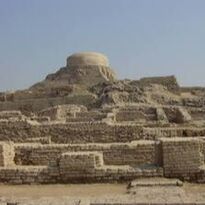Further Reading
Danielle Alesi, “A Crocodile’s Gaze." Dennys Frenez, Gregg M. Jamison, Randall W. Law, Massimo Vidale, and Richard H. Meadow, eds. Walking with the Unicorn: Social Organization and Material Culture in Ancient South Asia: Jonathan Mark Kenoyer Felicitation Volume, Archaeopress, (2018). Jonathan M. Kenoyer, “Indus and Mesopotamian Trade Networks: New Insights from Shell and Carnelian Artifacts,” in: Intercultural Relations Between South and Southwest Asia. Studies in Commemoration of E.C.L. During Caspers (1934-1996), eds. Eric Olijdam and Richard H. Spoor, 19-28, British Archaeological Reports Limited, (2008). ———-. “Trade and Technology of the Indus Valley: New Insights from Harappa, Pakistan,” World Archaeology 29 (1997): 262-280 Harappa Archaeological Research Project. Saira Iqbal, “Energy Efficiency in Architecture Design in Mohenjo Daro,” in: Cities’ Vocabularies: The Influences and Formations, ed. Nabil Mohareb et al. (Cham, Switzerland: Springer, 2021), 203-208 Nayanjot Lahiri, Finding Forgotten Cities: How the Indus Civilization was Discovered, Chicago University Press, (2013). R.N. Mehta, “Indigenous Perceptions of the Past,” Man and Environment 20:1 (1995): 1-5. Mohenjo Daro Title Song, via YouTube. Asko Parpola, “Religion Reflected in the Iconic Signs of the Indus Script: Insight into Long-Forgotten Pictographic Messages,” Visible Religion 6 (1988): 114-135. N. Kameswara Rao, “Aspects of Prehistoric Astronomy in India,” Bull. Astr. Soc. India 33 (2005): 499-511. Satyajit Ray, The Unicorn Expedition and Other Stories, Penguin Books, (2004). Adrija Roychowdhury, 'Mohenjo Daro: Ashutosh Gowariker, why are your characters calling their city ‘mound of the dead’?'. UNESCO site for Mohenjo Daro. Benjamin Valentine, George D. Kamenov, Jonathan Mark Kenoyer, Vasant Shinde, Veena Mushrif-Tripathy, Erik Otarola-Castillo, and John Krigbaum. "Evidence for Patterns of Selective Urban Migration in the Greater Indus Valley (2600-1900 BC): A Lead and Strontium Isotope Mortuary Analysis." PLoS One 10, no. 4 (04, 2015) “Why a Bollywood Film Has Been Accused of Distorting History,” BBC, (September 2016). Rita P. Wright, The Ancient Indus: Urbanism, Economy, and Society, Cambridge University Press, (2010). Music: "Evening Melodrama" by Kevin Macleod (www.incompetech.com)
0 Comments
Leave a Reply. |
Site Map |
© 2013-2024 Footnoting History. All rights reserved.
Footnoting History and the Footnoting History logo
are trademarks of Footnoting History, NY. Footnoting History operates under a SAG-AFTRA Micro-Monetized Podcast Agreement. |



